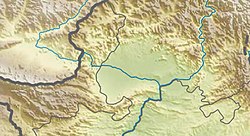Śalātura | |
|---|---|
| Coordinates: 34°2′54.5″N 72°21′56.1″E / 34.048472°N 72.365583°E | |
| Country | |
| Province | Khyber-Pakhtunkhwa |
| District | Swabi |
| Elevation | 308 m (1,010 ft) |
| Time zone | UTC+5 (PST) |
| Number of Union councils | 2 |
Śalātura was the birthplace of ancient Indian Sanskrit grammarian Pāṇini, regarded as the earliest known grammarian whose work has survived into modern times.[1][2][3] In an inscription by Siladitya VII of Valabhi, Pāṇini is referred to as Śalāturiya, meaning "man from Śalātura". This suggests that Pāṇini lived in Śalātura, an ancient city in Gandhara, likely near modern-day Lahor, Pakistan,[4] a small town situated at the confluence of Indus and Kabul Rivers in the Swabi district of Khyber-Pakhtunkhwa, 20 miles northwest of the Attock Bridge.[5]

According to the CE 646 book Great Tang Records on the Western Regions (大唐西域記) of 7th-century Chinese scholar Xuanzang, there was a town called Suoluoduluo on the Indus where Pāṇini was born, and he composed the Qingming-lun (Sanskrit: Vyākaraṇa).[5][6][7] He mentioned that a statue of Panini was in existence there.[8]

Within the city of F'o (or Sha)-lo-tu-lo was a tope where an arhat had converted a disciple of Panini. Five hundred years after the Buddha's decease a great arhat from Kashmir in his travels as an apostle arrived at this place. Here he saw a brahmin teacher chastising a young pupil : in reply to the arhat's question the teacher said he beat the boy for not making progress in etymology. The arhat smiled pleasantly and in explanation said — You must have heard of the treatise on Etymology made by the rishi Panini and given by him to the world for its instruction. The brahmin replied— "He was a native of this city; his disciples admire his excellences, and his image is still here". To this the arhat answered — This boy of yours is that rishi. He added that in his previous existence Panini had devoted all his energies to worldly learning but that from some good Karma he was now the teacher's son.
Panini describes in great detail the local accents used for the names of wells north and south of Vipasha (modern Beas) river. He also mentions the Yavanas, which is taken to be Greeks(Ionians).[9]
Prof. Ahmad Hasan Dani, the late Pakistani Sanskritist stated in a letter that the village has shifted and the old village was 3km to the west of the main road, where there was a big mound in ancient times. The mound has since been levelled down.[10]
- ^ Grammatical Literature, History of Indian literature, Volume 2; Volume 5 of Scientific and technical literature : Pt. 2.; Fasc. 2, Hartmut Scharfe, Otto Harrassowitz Verlag, 1977 p. 88
- ^ Bakshi, S. R. (2005). Early Aryans to Swaraj. Sarup & Sons. p. 47. ISBN 9788176255370.
- ^ Ninan, M. M. (2008). The Development of Hinduism. Madathil Mammen Ninan. p. 97. ISBN 9781438228204.
- ^ Sometimes referred to as Chota Lahore to distinguish it from Lahore
- ^ a b Hartmut Scharfe (1977). Grammatical Literature. Otto Harrassowitz Verlag. pp. 88 with footnotes. ISBN 978-3-447-01706-0.
- ^ Singh, Nagendra Kr., ed. (1997), Encyclopaedia of Hinduism, New Delhi: Centre for International Religious Studies : Anmol Publications, pp. 1983–2007, ISBN 978-81-7488-168-7
- ^ Mishra, Giridhar (1981). "प्रस्तावना" [Introduction]. अध्यात्मरामायणेऽपाणिनीयप्रयोगाणां विमर्शः [Deliberation on non-Paninian usages in the Adhyatma Ramayana] (in Sanskrit). Varanasi, India: Sampurnanand Sanskrit University. Retrieved 21 May 2013.
- ^ On Yuan Chwang's travels in India, 629–645 A.D., Watters, Thomas, London, Royal Asiatic Society p. 222
- ^ Lal, Shyam Bihari (2004). "Yavanas in the Ancient Indian Inscriptions". Proceedings of the Indian History Congress. 65: 1115–1120. ISSN 2249-1937. JSTOR 44144820.
- ^ [Panini, Saroja Bhate, Sahitya Akademi, 202, p. 4]


